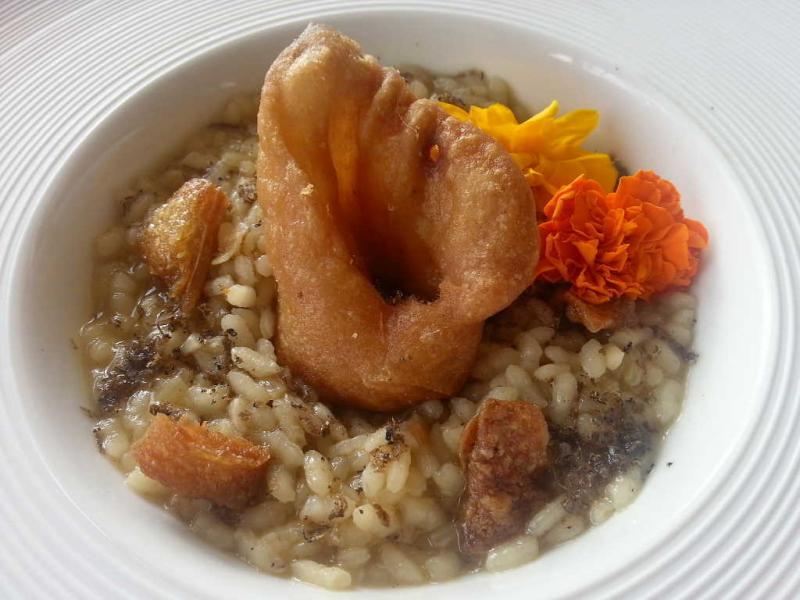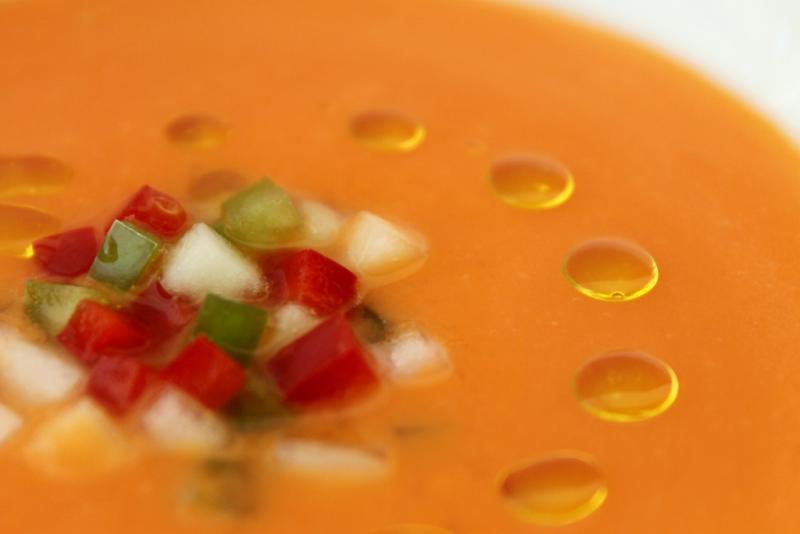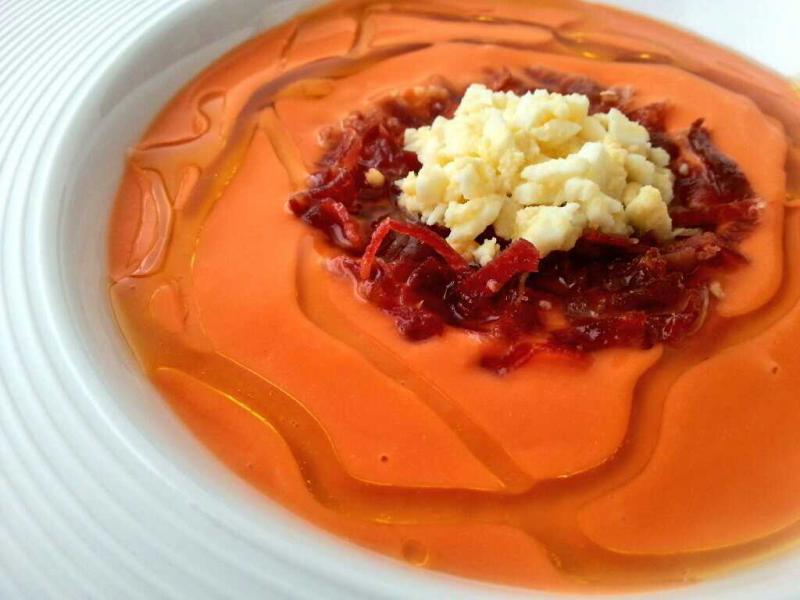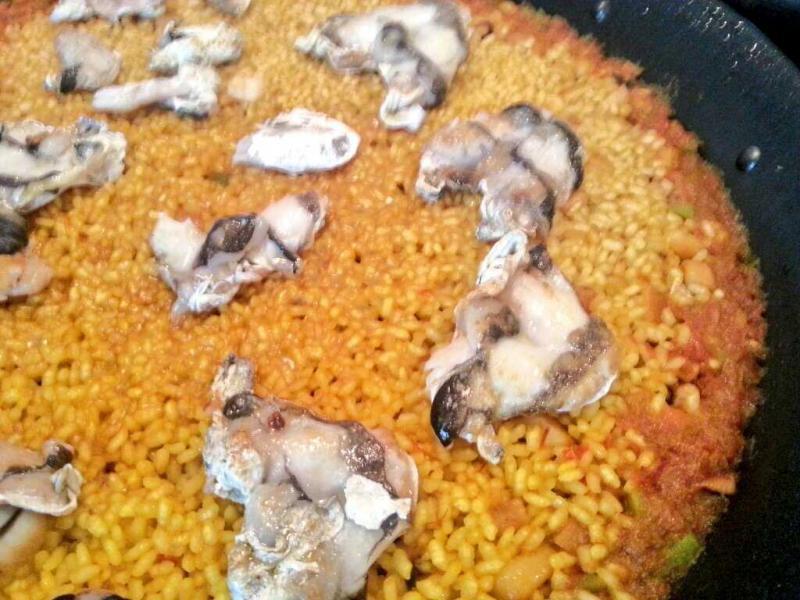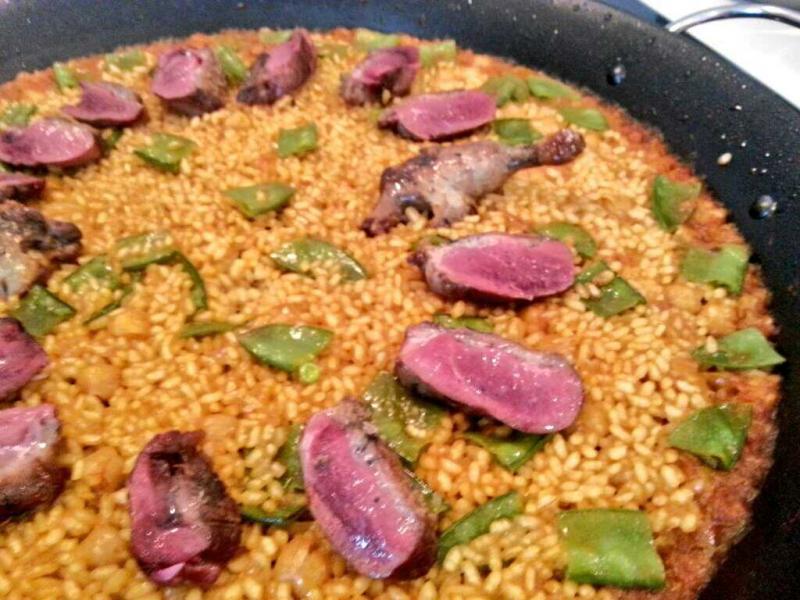
EnriqueB
participating member-
Posts
399 -
Joined
-
Last visited
Content Type
Profiles
Forums
Store
Help Articles
Everything posted by EnriqueB
-
This time italian instead of spanish (paella) rices. I had edible flowers and black truffle, which made for nice presentation and aroma. Pigeon risotto Pork & ham risotto with suckling pig ears (confited & deep fried)
-
Wonderful. I have to try this. I've been for a while searching for reasons to self-justify buying a dehydrator for which I don't have much space, and you have likely given me the definitive reason. My wife will hate you for yet-another-cooking-gadget A couple of questions: About how long do you boil the skin? And, what's the purpose of the pizza stone if it is cold and you put the meat side on it? To keep the meat cold so it does not overcook?
-
Looks good. Will it be available in Europe bookstores? Amazon?
-
Long ago without posting here. But I always check this thread and get lots of ideas, so now that I have downloaded pictures from the last months from my phone, I'll post some of the last dishes, starting with some "typical Spanish". During the summer we eat andalusian gazpacho and salmorejo cordobés (a more dense version of gazpacho) almost every day: Gazpacho andaluz, with brunoise of red and green bell peppers, onion, and cucumber Salmorejo cordobés, with ibérico ham and hard-boiled eggs And I have also started recently to make paella rices, such as: Paella rice with squid and hake cheeks Paella rice with mallard duck
-
I think sous-vide makes an excellent job with good prawns / big shrimp, see http://dorarnosella.com/2013/06/10/gamba-roja-sous-vide/ (in Spanish) This type of crustaceans change completelly around 50-55ºC, the temperature at which their digestive enzymes become most destructive. Sous-vide is great for cooking them below that temperature, so they keep some of their raw qualities (sweetness and tenderness) but do not feel totally raw. I do it with fresh prawns tails, but if that is too risky (as pasteurization is not achieved) I use good quality prawn fast-frozen at capture. This should disable parasites (prawns do not have anisakis risk but may have other parasites). Then I bag the tails (often with a bit of butter and spices, but no salt) and dip the bag around 15 seconds in boiling water to pasteurize the surface. Remove to very cold water, then cook sous-vide for 15 to 20 minutes (depending on diameter) between 45 and 50ºC (depending on preference).
-
The state of the market for consumer sous vide equipment
EnriqueB replied to a topic in Kitchen Consumer
Hi DiggingDogFarm, would be please be so kind as to give some more details/tips/profiles on this usage? I make some charcuterie but never though to ferment it sous-vide. The idea was highlighted in Modernist Cuisine. Discussion here.... http://forum.chefsteps.com/discussion/comment/7323/#Comment_7323 Temperatures and times will depend on the culture used and desired results. Thanks! I've read Modernist Cuisine beginning-to-end but at the time I didn't make charcuterie and did not remember about it. I'll look it up. -
The state of the market for consumer sous vide equipment
EnriqueB replied to a topic in Kitchen Consumer
Hi DiggingDogFarm, would be please be so kind as to give some more details/tips/profiles on this usage? I make some charcuterie but never though to ferment it sous-vide. -
I am surprised at this. I wrote to Polyscience some months ago asking a number of questions, among others what happened under a power fail, and their answer was, literally (boldface mine) "In the case that the unit shuts down due to a power fail, the screen will display "fail power" and will reset. It will not go back to the temperature it was previously at due to safety reasons."
-
If it keeps for a month at standard refrigeration temperatures, it must have received some type of treatment. See this document and this guide from the UK Food Standard Agency, which summarizes the usual recommendations for companies doing this type of packaging. The duck breasts must have been either cured with nitritres, or given a heat treatment equivalent to 10 minutes at 90ºC. If, as you say, the cold chain is not maintained, or the expiry date ignored, the meat can for sure become deadly poison. But it does not have to. It may not have any spore to begin with. Or, even if there was some spore germination and toxin production, it normally stays on the surface and may be disabled from the high heat of meat searing.
-
The only thing you can do is ensure cold conditions (very fast chilling in the case of sous-vide food, then refrigeration at <3ºC) and limit refrigeration time (depending on refrigeration temperature, water activity, pH, etc this may go from just a couple of days to maybe 10 days). See this document from UK Food Standards Agency.
-
¡Oh!, thanks for clarifying.
-
Precisely. What puzzles me is that I cannot tell a difference in taste between the two versions. Hence, the question: are we attached beyond reason to the tradition, or is my ability to tell a difference in taste compromised? I guess someone who has tried cooking the legs sous-vide both ways can chime in. Thanks! FWIW, Nathan Myhrvhold said that they (the Modernist Cuisine team) made blind tests and they could not detect any difference, in a message in this very forum.
-
Hi Nick, re: refrigerator temperatures I can't seem to find my reference right now. I thought I read it in MC or McGee, but a quick flick through McGee didn't show it up. In any case, if you put hot food in the fridge, it does not warm up the rest of the fridge any more than opening the door would. The thermostat on your refrigerator regulates the temperature and takes care of thatHi Keith, I think I remember Modernist Cuisine claiming the opposite. There was a "heat-map" photo (taken with infra-red camera or something similar) showing how foods close to the hot one and the whole area around were much hotter, in fact moving into non-safe temperatures.
-
Thanks, Anna N, rotuts, ePressureCooker, I'm glad my comment was useful.
-
I can't provide any information as to sous vide, never having done it, but I can add re the pressure cooking and the gelatinization issue (versus traditional methods) I can always get far more gelatinized stock than I can ever manage with stovetop methods. Pressure cook chicken bones and scraps for 90 minutes to make stock, and its going to be practically rock hard from the gelatin after refrigeration overnight. Cook a whole chicken for 20 - 25 minutes in the pressure cooker, and the cooking liquid is going to be pretty firm, after refrigeration. Even if I just cook chicken parts for a few minutes, I'll get some gelatinization. I never got those kind of results from traditional cooking methods, well, unless I simmered stock for a long time, and even then, I don't remember getting so much gelatin as I do now. And gelatinization means not only connective tissues breaking down (thereby reducing what many of us would call "gristle" / inedible parts in tougher meat cuts), but increased flavor. That's absolutelly true, ePressureCooker, and one of the reasons why stocks are better cooked in a (non-venting, spring valve) presssure cooker. Another reason is that aromatic volatiles are better retained, and yet another one that slight Maillard reactions take place, which improve flavour. In fact, "white stocks" are never "that white" in the pressure cooker. And, if you look for very subtle flavor & aroma, SV or low-temp traditional are better, for example I prefer those methods for vegetable & fish stocks. On the other hand, for stews I don't always want the strong gelatin extraction of the pressure cooker, and I may prefer a bit less gelatin in exchange of a not-so-dry meat.
-
I've prepared similar dishes SV, conventional stew, and PC. Not side-by-side but sequentially. For example, I've done oxtail SV (100 hours @ 60ºC, as per MC), braised (7 hours @ around 85ºC, as per TK, French Laundry), and PC (1 hour @ around 120ºC). I consider these are simply different dishes, especially SV vs the other two. There are essential differences between the methods. First, the chemical reactions taking place in tough meats at 60 and 120ºC are the main difference. At 60ºC juiciness and colour are retained, but it takes absurd times to transform collagen to gelatine. If you are willing to wait that time, the result is, IMO, incredible, with a mixture of features of traditional tender meat (redness, juiciness, tenderness) and the stronger taste of a tough cut and the nice mouthfeel of gelatine. Increasing temperature starts to draw moisture out of the meat and the red colour turns to brownish/grey. This is only compensated in traditional stews by the transformation of collagen to gelatine, which makes the meat "feel" tender at the mouth. But, organoleptically, the meat is completelly different from the 60ºC one. Juiciness and colour changes take place up to around 75ºC, any higher temperature will not change things much for them, whereas the hidrolysis of collagen takes place exponentially faster as we continue to increase temperature. That's why the traditional stew will not be so much different from the pressure-cooked one at around 120ºC, but can be cooked much faster. But when cooking at 60ºC you don't produce the wonderful sauce that you get at 80ºC and higher, as much less juice and collagen is extracted from the meat. So, if you want a result closer in that sense to a traditional stew you have to work extra to create a delicious "jelly-like" stock, and them integrate the elements somehow (but integration cannot be as good as traditional). You also cannot add vegetables to the SV bag, as they need a higher temperature to break down their pectine walls, so again you need to work out those component separatelly. In both SV and PC methods you cannot easily add items to the dish as it is cooking, depending on their different cooking times, as you can in a traditional stew. You cannot easily verify "doneness" neither. At the end, you get quite different results. Preferring one or another boils down to personal preference or the result you're looking for. I like all three, choosing one or the other just depends on the time I have available and/or the exact result I want for a given dish.
-
220v model and very reasonable cost for sending overseas. But this is likely a non-issue for most people in this forum Otherwise, feature by feature I would choose the Anova.
-
Modernist Cuisine proposes a lower temperature and longer time for in-shell egg pasteurization: 2 hours at 55ºC. I have used it but could not find a scientific paper to back it up, as for the proposed profile from previous comments. Harold McGee says pasteurized eggs can replace fresh eggs in any application, though they may lose some emulsifying capacity and slightly alter the soft taste of eggs. But most likely he refers to higher heat pasteurization. I have prepared mayo with pasteurized eggs without noticing any loss of emulsifying power.
-
Thanks! Bone marrow cooked with the onion sounds incredibly. Is it raw bone marrow, and out of the bone, or in-the-bone? Raw marrow, out of the bone. I swore to myself I'd never take a picture of an onion again, but this was from last year, so here you go: Thanks so much!!
-
Thanks! Bone marrow cooked with the onion sounds incredibly. Is it raw bone marrow, and out of the bone, or in-the-bone?
-
mm84321, could you please give some hint on the preparation of that wonderful-looking soup and croutons? Would love to prepare it.
-
I find that a really bad design choice. None of the 5 different sous-vide units I've used behave like that (i.e. they don't turn off).
-
Of course it has much more. Like +/-0,05ºC stability and heating up to 50 l baths. Just saying it is by far the best timer implementation I've seen (I have 3 different rigs) or read about. Not a reason to buy the unit, but a smart and well-implemented feature.
-
Thank you for the reply! So what is the point of it turning itself off? Isn't the point of sous vide that you can leave food in the bath for at least a certain time but if you go over that time a little it isn't going to affect the food as much if you left something in an oven or on the grill for 15 more minutes? Also, isn't that a health hazard if it turns itself off and then the food you have in the bath sits in the water as the temperature slowly drops? I'm new to sous vide circulators, but is this how the Polyscience also works? Once the timer hits zero it turns itself off? Thank you! Really it makes much more sense to set a separate timer. Then if you can't attend to it immediately you can re-set your timer and your food keeps on cooking. I'm curious as to how you would like the timer in the SV unit to work. I just don't see the reason for the timer to turn the circulator off. When you put the timer on the oven does the oven turn off? If it beeps after the 45 minutes I set it for then I know the minimum time has been reached and now I can pull it out whenever I want and know that it's cooked for the minimum time. I realize it isn't a big deal because I can keep track of time woth the watch on my arm, but i didn't understand what purpose shutting the circulator serves. I am guessing we have differing expectations of the purpose of a timer function. When I set the timer on my dryer it shuts off when time is up. When I set a timer on my counter top induction hobs they shut off when time is up. Similarly with my microwave. So I am led to expect that is the purpose of the timer function on an SV unit. You have other expectations and you are surely entitled to them. I have never tested the timer on my Demi but I certainly will sometime today to see if it too shuts off. You have aroused my curiosity. I think Addélice SWID is the unit that better solves this. If you set the timer, it will time down to zero, then beep and turn on a led signal. The unit is not switched off. At the same time, a timer up is started so when you arrive you see that the time has finished and how much additional time has gone by. If you don't set the timer at all, it starts the timer up as soon as the cooking process starts (i.e. when temperature is reached and you then click a button to indicate that you have introduced the food pouches in the bath) and will always inform you of the total cooking time, which is usually my favorite option.
-
rotuts, with pork and chicken, a few hours in a 4% salt water brine does wonders with the sous vide method. Generally people say not to salt meats like beef since the salt draws juices out of it. But people dont normally brine beef, and when you brine pork or chicken its does the opposite and retains the juices. If you worried about being salty, 4% is on the lower side of most brines, but if your concerned, just rinse the ribs off good after you remove them from the brine. After numerous side-by-side comparisons, I stopped brining and even just salting before bagging, whenever I am cooking below around 60ºC. At such low temperatures meats lose such few liquid during cooking that brining really does not help much, but it changes meat texture. I didn't realize until I did side-by-side tests with the same pieces cut in two. Meat salted after cooking SV retains a "fresh" feeling, with meat threads clearly splitting between your teeth, whereas pre-salted or brined, even in low concentrations, disolves myosin and other salt-soluble proteins that glue meat threads together and produces a kind of sausage/cured meat texture. Only slightly, of course, and you may like it or want that texture at times. For example, it's nice if you are going to eat the meat cold and slice it thin, e.g. for sandwiches. But I don't want that texture for most hot meat meals. This effect can be perceived even with relatively short cooking times of about 2 hours and consuming inmediately. I still do brine poultry and pork that is going to be cooked SV above 60ºC or with high temperature methods, as the juices retention predominates in these cases.


